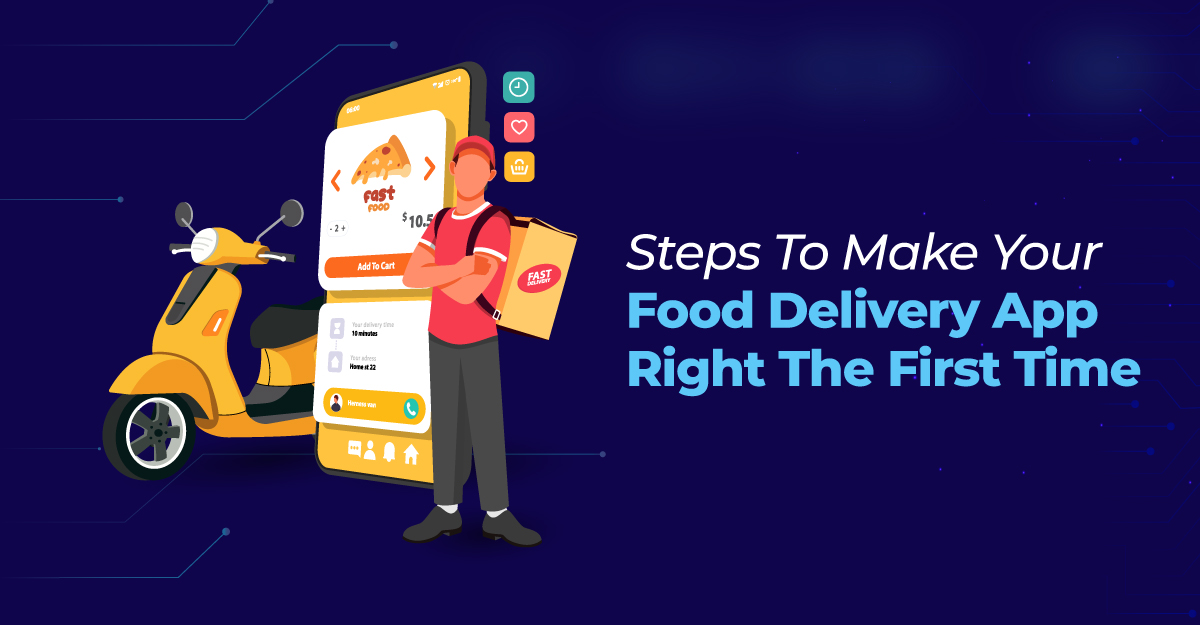In today's fast-paced society, the ease of online food ordering has seamlessly integrated into modern living. Food delivery applications have transformed our dining experience, providing many culinary choices within arm's reach. Given the growing demand for these apps, aspiring entrepreneurs are setting their sights on the food delivery industry to leave their mark.
If you find yourself among this group, it's crucial to fully understand the intricacies of developing a food delivery app to ensure the success of your venture. This article delves into the essential stages to steer you in creating a seamless-running food delivery app right from its inception.
Why Should You Invest in Food Delivery App Development?
The rise of food delivery apps is not coincidental; it's a response to changing consumer preferences. People seek convenience and efficiency today, and a food delivery mobile app development company offers just that.
Sporting a user-friendly interface and an extensive array of dining choices, these applications allow customers to satiate their cravings while remaining within the confines of their abode. For business visionaries, delving into food delivery app development unveils opportunities within a profitable market with no indications of deceleration.
The Different Types of Food Delivery Mobile Applications
Before diving into the development process, it's crucial to understand the different types of food delivery apps:
1. Aggregator Food Delivery Applications:
These applications serve as intermediaries connecting customers with various restaurants. They gather menus from numerous eateries, allowing users to select from various choices.
2. Logistics Support Food Delivery Applications:
These applications focus on the delivery process. They collaborate with restaurants lacking delivery services, furnishing the necessary infrastructure to ensure seamless order completion.
3. Restaurant-Specific Application:
Some restaurants opt for their own apps to streamline the ordering process. These apps cater exclusively to their menu items and provide a customized experience to their loyal customers.
Revenue Model of Food Delivery Mobile Applications
Understanding the revenue model is essential for the sustainability of your food delivery app:
1. Delivery Charges:
Charging customers a fee for the delivery service is a straightforward way to generate revenue.
2. Peak Pricing:
There is a possibility to implement both higher delivery charges along with peak pricing. Thus, one can handle heavy demand during peak time.
3. Commission:
When any restaurant collaborates with your platform, you charge them a certain percentage of the total order for using your platform.
4. Advertisement:
Restaurants can be benefited by promoting their special dishes, deals, etc. This gives them an extra earning opportunity.
Steps To Make Your Food Delivery App Right The First Time
1. Finalize the Significant Features:
Identify the elements which will be the main USP’s (Unique Selling Point) of your application. This can be anything, such as secure payment mode, easy reordering feature, real-time tracking of orders, customized recommendations, etc.
2. Selecting The Tech Stack:
The performance, security and the scalability of your app largely depend on the technology stack you choose. The developers of a mobile app development company can help you to choose the type of databases, programming languages, and frameworks that can work best for your app.
3. UI/UX Design And Tech Factors to Consider:
Emphasize on the user interface (UI) and experience; the program should be simple to use, attractive, and adaptable to many devices. Moreover, take into account elements like information security and application speed.
4. Choosing The Right Development Company:
Collaborating with a reputable app development firm recognized for its impressive track record in developing food delivery apps. They have the capacity to facilitate the development process.
5. Determining the Cost of Food Delivery Apps in the USA:
The expenses of making an app can vary depending upon different factors like features of the app, user-friendliness, cost of mobile app development and location. Understanding your budget thoroughly is essential if you want to avoid unforeseen financial difficulties.
Features to Consider When Developing an Exceptional Food Delivery Mobile Application
1. User Registration and Profiles:
Concentrate on how you can bring improvements in the registration process. This will enable to easily handle their user profiles and filter/check their odder history.
2. Real-time Tracking:
GPS will enable to track the orders. Hence, this technology must be implemented.
3. Menu Customization:
Users must have the option to customize their orders that are suitable to their needs/preferences.
4. Secure Payments:
The payment gateways must be flawless to ensure a safe payment process.
5. Rating and Reviews:
Empower clients to rate and review cafés and their delivery experiences, building trust inside the local area.
Selecting The Tech-Stack
Choosing the appropriate technological stack is one of the most important decisions you'll make as you design a food delivery application. Backend and frontend technologies in your technological stack determine your application's architecture. This decision greatly impacts the program's usefulness, efficiency, and adaptability.
Backend Technologies
Some backend technologies that are often used for app creation are:
- Node.js: Due to its real-time capabilities and lightweight design, Node.js is ideal for designing flexible and fast backend frameworks.
- Ruby on Rails: Easy to use and rich code structure is its hallmarks. Development is accelerated without sacrificing quality.
- Django: Python-based for fast development and protection.
- Firebase: Google Firebase provides authentication, real-time storage, and cloud development for backend developers.
Front-end Technologies
The most prevalent front-end app tools are:
- React: Component-based design and fast rendering allow React to develop interactive and dynamic user interfaces.
- Angular: Google's Angular has many capabilities and a good working environment.
- Vue.js: Vue.js is flexible and futuristic. It's easy to add to projects and adaptive to complexity.
- Flutter: Flutter, from Google, can construct iOS-Android apps.
Consider These Design and Technical Considerations Before Developing A Food Delivery App
1. Responsive Design:
Check your app's compatibility across devices and screens.
2. Intuitive UI:
Make a basic UI so clients can find the app.
3. Fast Loading:
Faster application opening reduces consumer dissatisfaction.
4. Data Security:
Execute strong safety efforts to safeguard clients' private and financial data.
Selecting the Appropriate Development Company
Choosing the ideal development company is a significant decision that demands fastidious consideration. Before making any choices, carefully researching India's mobile application development cost is essential. Identifying a capable and dedicated team that grasps your distinct vision and flaunts a strong history of successful tasks is vital. Besides, a development company fit for giving widely inclusive end-to-end solutions holds enormous importance.
Accordingly, find an opportunity to explore potential partners, inspect their portfolios, figure out their methodology, and assess their ability to align with your needs. This selection process can fundamentally add to a definitive outcome of your food delivery application venture.
Cost Of Developing Food Delivery Application
The food delivery mobile app cost in India can vary widely depending on the features, complexity, platforms, and development company. Getting accurate cost estimates upfront is essential to plan your budget effectively.
Conclusion
Accomplishing success in creating food delivery applications like Zomato and Swiggy requires careful planning, complete attention to detail, and productive partnerships with talented specialists. Despite the severe competition in the food delivery industry, a nicely planned application, a solid budget strategy, and an unwavering commitment to consumer loyalty can immovably lay out your presence in this flourishing business market.



